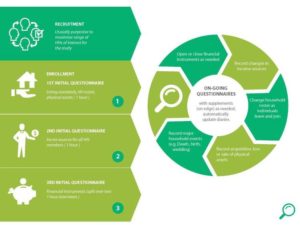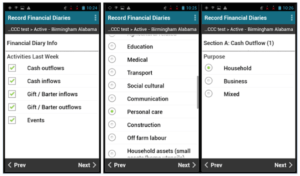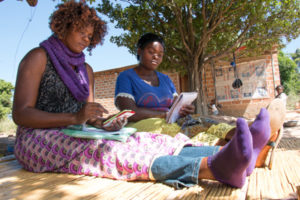
Search
In 2015, Catholic Relief Services (CRS) sent smartphone-toting field data collectors with digital financial diaries to seven villages around the town of Kasama, in Zambia’s Northern Province, to help answer an important question: Could CRS’ local savings and lending group model expand financial inclusion and improve resilience for vulnerable households?
Using a financial diary on each mobile device to record the financial behavior of 272 households, through more than 200,000 cash, barter, in-kind and financial transactions, CRS got its answer in preliminary study findings. Its Savings and Internal Lending Communities (SILC) doubled the rate of large business and household purchases for all SILC members with funds from loans, savings dividends and small, frequent savings deposits. The most significant increases were in the payment of school fees and household asset purchases.
Financial diaries methodology proved to be a powerful tool for studying financial inclusion in Zambia, but practitioners of this highly detailed and time-consuming monitoring and evaluation technique would not have reached their desired research breadth and depth had they not completely switched from paper-based to digital tools about 40 weeks into the more than two-year data collection and analysis effort.
Using a mobile data collection and analysis app (which also worked offline) and a cloud-hosted database, CRS drew household data from rural areas in real time – even when connectivity was spotty – and accurately amassed thousands of data points generated by tracking people’s financial lives each week. At the same time, a CRM tool built into the app increased the productivity of field teams collecting this data by allowing CRS to set goals for each survey agent and track progress against those goals.
 Financial Diary Methodology. Source: Bankable Frontier Associates
Financial Diary Methodology. Source: Bankable Frontier Associates
CRS Research Officer Samuel Beecher, who managed the work, said mobile tools helped ensure data quality for a key component of financial diary research:
“One often-overlooked part of financial diaries data collection and data quality is balance checks: making sure that weekly inflows and outflows sum to the same number. … It is common for weekly inflows and outflows not to match at first glance as the respondent may intentionally or unintentionally leave out all of the transactions.
“After switching to mobile technology it was much easier for the imbalances to be identified in a timely manner and for the enumerator to visit the household soon after the initial interview to probe about their transactions and correct the data.”
First tested in Bangladesh in 2000, financial diaries were popularized in 2009 with the publishing of “Portfolios of the Poor.” Financial diary-based research has “changed the financial inclusion and microfinance sector by revealing that the poor are adept money managers leading complex financial lives,” wrote research funders from the MasterCard Foundation, which provided financial support to the CRS effort, combined with research help from Microfinance Opportunities. Digital diaries have gauged the financial strains facing smallholder farmers in Mozambique, Pakistan and Tanzania as well as the poor in Kenya and Mexico. They were recently used in the U.S. Financial Diaries project to uncover the income volatility that has unsettled many U.S. households since the 2008 recession.
When they each began their individual financial diary projects, both U.S. Financial Diaries and CRS researchers headed down the paper path only to switch gears once they found software that could digitize their work. In CRS’ case, the solution came from TaroWorks, our mobile data collection and analysis app, which is also an offline CRM and field force management platform, powered by Salesforce.
Beecher knew that using financial diaries in Zambia could provide insight into household financial behavior but recognized the obstacles presented by paper data collection:
“The panel nature of the (financial diaries) survey allows for more accurate measurement of the frequency and magnitude of different transaction types because of the number of interviews conducted. The longitudinal nature of the study allows for the analysis of trends, and the detailed nature of the data allows for in-depth case studies of individual households.
“The data collection process at the start of the project relied on paper data-entry sheets that a team of three full-time data clerks entered into an Access database. … The project decreased 24 working hours each week by having the enumerators enter the data directly into the database via the phone, not to mention the time enumerators saved conducting the surveys by entering the data on the phone compared to writing it on a paper questionnaire.”

Financial diary mobile survey using TaroWorks. Source: Catholic Relief Services
The U.S. Financial Diaries team’s data collection task was equally daunting, according to their recounting of survey methodology.
“The volume of information gathered during the interviews could be large – on average, field researchers recorded 56 separate cash flows in an interview (cash flows are defined as the movement of money into or out of a household, or between financial instruments).
“The study was designed with mechanisms to mitigate the burden of collecting such detailed data. One such mechanism was that each diary questionnaire would inform the next so that subsequent questionnaires would eliminate redundant information and be automatically adjusted for new or different information. However, because of the demands on field researchers and the challenges described above, data entry sometimes lagged data gathering. … The hiring of additional data entry staff and our transition to having fieldworkers enter data in real time using tablets mitigated this challenge over time.”
Timothy Ogden, who oversaw the U.S. Financial Diaries project as managing director of the Financial Access Initiative, told the publication Next City that earlier methods of collecting data on financial lives didn’t provide enough detail and substituted direct observation with fuzzy recollection.
“Most of previous research on financial lives was based on phone surveys, one time, try to get people to recall over a whole year, their financial lives,” Ogden said. (Read more.)
In contrast, CRS enumerators moved to each research village when the project began and lived among the survey households for the entire study period, becoming a part of the community and developing a level of trust with the study subjects, which allowed them to dive deeply into each household’s earning, spending and savings patterns.
Beecher believes there are other advantages to using a mobile data collection and analysis application and offline CRM to gather and analyze financial diary data – beyond the ability to handle large data sets, as was the case in Zambia where more than 55,000 financial diaries were created across 272 households.
 CRS Financial Diaries Interview. Source: Henry Tenenbaum, 2016/Catholic Relief Services
CRS Financial Diaries Interview. Source: Henry Tenenbaum, 2016/Catholic Relief Services
Among the obstacles overcome and lessons learned by Beecher and his CRS colleagues using mobile technology to enhance and scale financial diary collection:
Editor’s Note: This blog post was originally published on NextBillion
POST TOPICS
Sign up to receive emails with TaroWorks news, industry trends and best practices.
TaroWorks, a Grameen Foundation company.
Site by V+V